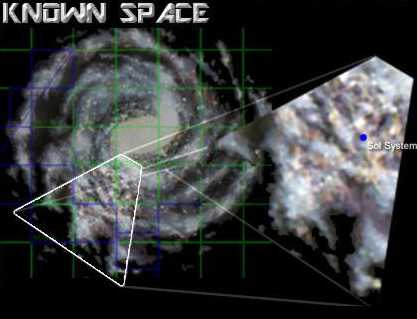| Galactic Map |
![Lightning Bolt [Top]](dark_top.gif)
Ten billion years ago, 5 Billion years after the Universe formed, galaxies began to form. Our own galaxy is considered average among other spiral galaxies. The Milky Way is an estimated 100,000 light years across and 2000 light years thick. 140 billion to one trillion stars burn within the galactic halo. The estimated number of life-bearing planets are in the millions -- and even with a small percentage of those containing sentient life, the sheer amount of alien life is staggering. Of course, only a very small number of sentients have been contacted.

Known Space is a considerably small portion of the galaxy covering parts of the Saggitarius, Local, and Perseus Arms. Hindered by current hyperspace technology, it would take centuries to explore even a small portion of the galaxy. Although expeditions to the Galactic Core have been planned, none have been carried out. One can only dream of the dense aggregation of billions of stars approximately 0.1 light years apart.

Our nearest large galactic neighbors are the Large and Small Magellanic Clouds (52,000 and 63,000 parsecs respectively), the Andromeda Galaxy (670,000 parsecs distant), and the Triangulum Galaxy (or M33), 730,000 parsecs distant.
[Editor's Note: 1 parsec = 3.24 light years]
Go to Top
![]()
![Lightning Bolt [Bottom]](dark_bottom.gif)
Comments, criticisms, suggestions, and additions welcome! E-mail Dan Fournel at [email protected]
Best experienced with ![]() Click here to start. Microsoft
is a registered trademark and the Microsoft Internet Explorer Logo is a trademark of
Microsoft
Click here to start. Microsoft
is a registered trademark and the Microsoft Internet Explorer Logo is a trademark of
Microsoft
This page was last edited on: June 08, 2000
Go to Top
